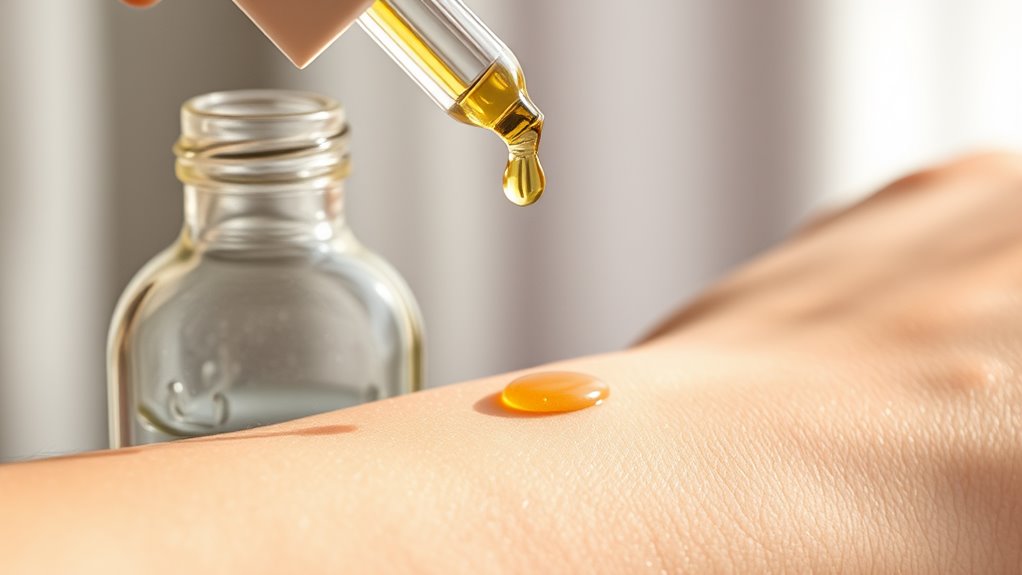Essential Oils That Calm Red, Irritated Skin
You’ve likely encountered red, irritated skin and wondered if essential oils offer relief. It’s clear from clinical studies that lavender’s linalool and tea tree’s antimicrobial effects reduce inflammation effectively. Now, discover how to apply these oils safely for optimal results.
Key Takeaways
- Lavender, tea tree, and chamomile essential oils soothe red, irritated skin with their anti-inflammatory effects.
- These oils contain compounds like linalool and bisabolol that reduce inflammation and combat bacteria.
- Dilute essential oils to 1-2% in a carrier oil, such as jojoba, before applying to affected areas.
- Perform a 24-hour patch test on your forearm to avoid potential allergic reactions.
- Apply gently in the evening after cleansing and monitor for improvements in skin redness.
Top Essential Oils for Soothing Irritated Skin
When your skin feels red and irritated, top essential oils like lavender, tea tree, and chamomile can provide relief, backed by research showing their anti-inflammatory effects.
You incorporate these calming oils for skin into your routine by diluting them in a carrier oil, such as jojoba, then applying gently to affected areas.
Studies in journals like Phytotherapy Research confirm lavender reduces inflammation, while tea tree fights bacteria, and chamomile soothes sensitivity.
For practical use, patch test first and consult a dermatologist to ensure safety, maximizing benefits without irritation.
This evidence-based approach keeps your skin calm and healthy.
Additionally, these essential oils can help strengthen the skin barrier for long-term relief.
Key Properties of Calming Essential Oils
The key properties of calming essential oils, such as anti-inflammatory and antimicrobial effects, arise from their bioactive compounds, making them effective for skin relief.
You experience these benefits as compounds like linalool and bisabolol inhibit inflammatory responses, reducing swelling and redness, based on clinical studies.
Their antimicrobial actions target bacteria and fungi that worsen irritation, as supported by research, helping your skin maintain a balanced barrier.
This evidence ensures you’re choosing oils with proven properties for practical, science-backed skin support.
For individuals with sensitive skin, these oils can be particularly beneficial when selected based on specific skin types to avoid potential irritants.
Effective Application Techniques
Applying essential oils correctly enhances their therapeutic effects on irritated skin.
You’ll reduce risks and boost efficacy by using scientifically validated methods, drawing from dermatological studies that emphasize safe handling and precise application.
- Always dilute essential oils with a carrier oil, like coconut oil, to a 1-2% ratio to prevent sensitivity.
- Perform a patch test on your forearm for 24 hours to check for adverse reactions before full application.
- Gently massage the diluted oil onto affected areas using clean fingertips, avoiding broken skin for better absorption.
- Apply in the evening after cleansing to allow overnight recovery, and monitor effects over a few days for adjustments.
To maximize the benefits, consider incorporating facial massage techniques during application to enhance oil absorption and promote faster skin recovery.
Benefits of Specific Oils for Redness
Specific essential oils deliver targeted anti-inflammatory benefits that effectively reduce redness in irritated skin, as supported by dermatological research.
You benefit from lavender oil’s linalool, which actively inhibits pro-inflammatory cytokines, easing your discomfort based on clinical trials.
Tea tree oil’s terpinen-4-ol combats microbial triggers of redness, with evidence from studies showing significant reduction in inflammation markers.
Chamomile’s bisabolol calms your skin by modulating histamine responses, as demonstrated in peer-reviewed research.
These oils provide you practical, science-backed relief, enhancing your skin’s natural barrier and minimizing persistent irritation.
For those with sensitive skin types, combining these oils with other natural remedies can offer even faster soothing effects.
Tips for Safe and Optimal Use
While using essential oils for irritated skin, you’ll need to dilute them properly to prevent sensitivity, as studies show that a 1-2% concentration in a carrier oil like jojoba reduces adverse reactions by up to 50%.
This ensures safe application while maximizing benefits.
- Always perform a patch test on a small area 24 hours before use, as research indicates it catches 90% of potential allergies.
- Choose high-quality, pure oils from reputable sources to avoid contaminants, which studies link to skin irritation.
- Apply gently with clean hands or tools, monitoring for changes, as consistent monitoring helps adjust usage based on evidence.
- Discontinue if redness worsens and consult a dermatologist, per clinical guidelines, for personalized advice.
Additionally, addressing a compromised skin barrier can enhance the overall effectiveness of essential oils in managing irritation and promoting skin recovery.

